Pachysphinx occidentalis, the Big Poplar Sphinx
Pachysphinx occidentalis occidentalis
(H. Edwards, 1875) Smerinthus
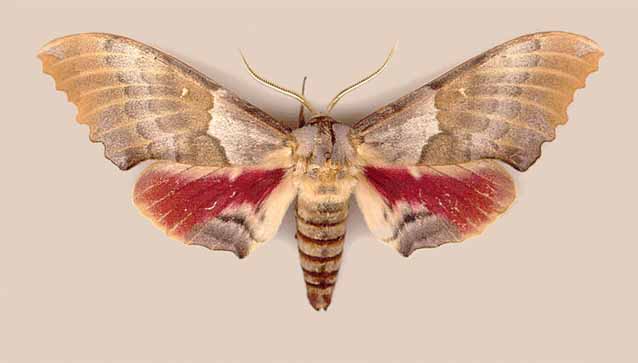
Pachysphinx occidentalis (pale form) by William A. Harding.
This site has been created by
Bill Oehlke at oehlkew@islandtelecom.com
Comments, suggestions and/or additional information are welcomed by Bill.
TAXONOMY:
Family: Sphingidae, Latreille, 1802
Subfamily: Sphinginae, Latreille, 1802
Tribe: Smerinthini, Grote & Robinson, 1865
Genus: Pachysphinx Rothschild and Jordan, 1903
Species: occidentalis occidentalis (Henry Edwards, 1875)
|
MIDI MUSIC
It's a Wonderful World
copyright C. Odenkirk
ON.OFF
<bgsound src="world.mid" LOOP=FOREVER>
|
DISTRIBUTION:
Pachysphinx occidentalis occidentalis, the Big Poplar Sphinx
(Wing span: 5 1/8 - 5 7/8 inches (13 - 15 cm)), flies in riparian
areas and suburbs from Alberta and North Dakota
west to eastern Washington; south to Texas, Arizona,
southern California, and Baja California Norte.
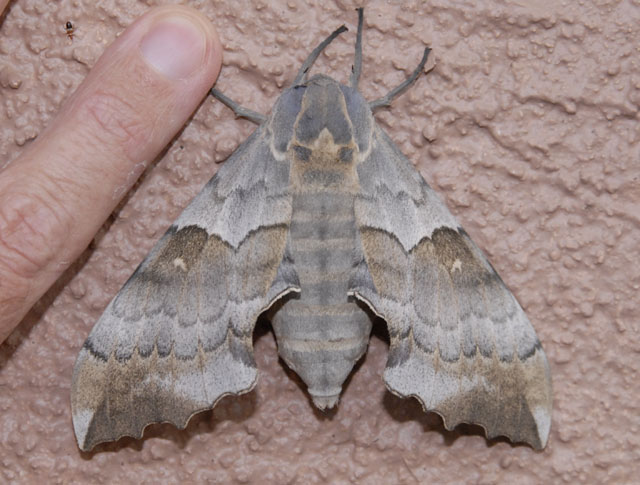
Pachysphinx occidentalis female, Silver City, New Mexico,
August 6, 2007, courtesy of David R. Furnas.
There are two color forms: the upperside of the forewings is yellow
brown in the pale form and dark gray in the dark form.
Lines and bands are well-defined. The upperside of the hindwing has a
crimson patch covering varying amounts of
the wing, and two dark lines which do not form a distinct triangle.
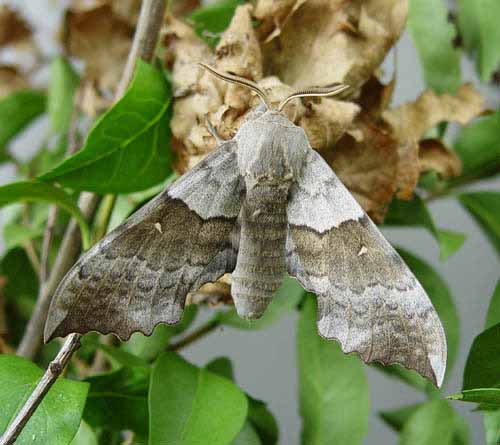
Pachysphinx occidentalis male, courtesy of
Martin Jagelka
Visit Pachysphinx occidentalis,
Payson, Gila County, Arizona, July 24, 2009, courtesy of Lauren Paterson.
FLIGHT TIMES:
Male and female Pachysphinx occidentalis moths come to lights as two broods in
southern Arizona from May-September, and as one brood northward from June-August.
Nick Richter of Lake Forest, Orange County, southern California, reports his second brood larvae have begun pupating, November 29, 2012.
The adults do not nectar at flowers.
Many thanks to Jeanne Marker who provides this "early bird" surprise.
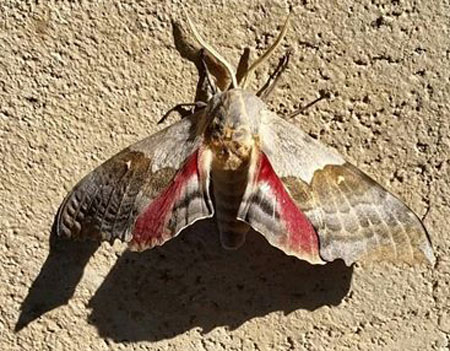
Pachysphinx occidentalis, south of Tucson, Pima County, Arizona,
March 19, 2015, courtesy of Jeanne Marker.
Jeanne was surprised to see this moth so early (March 19-20, 2015), and I (Bill Oehlke) indicated to her, "Usually in southern states they do not begin to appear until May.
If pupation was in soil near south side of a home where soil would warm faster than in a much more wooded area, and you have had a bout of relatively warm weather,
those factors may have triggered the early development and eclosion. Thanks for thinking of me."
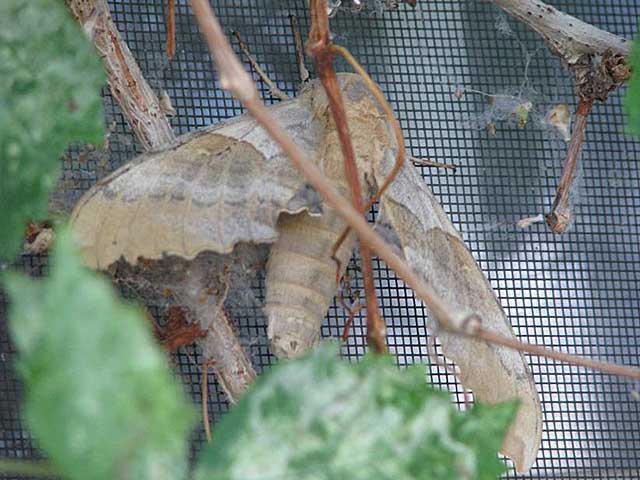
Pachysphinx occidentalis, Washoe Valley, Washoe County, Nevada,
June 20, 2012, courtesy of Terri McLaughlin.
ECLOSION:
Little is known about the eclosions of the earth pupators, but
many believe pupae wiggle toward the surface just prior to emergence.
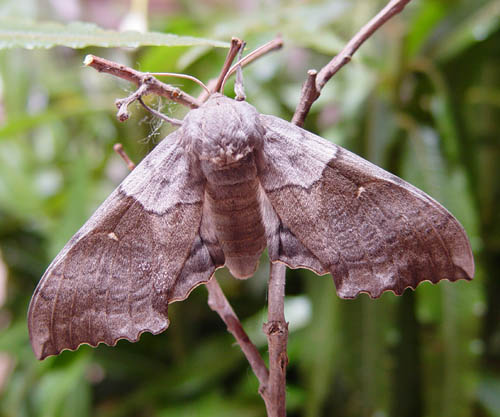
Pachysphinx occidentalis female, courtesy of
Martin Jagelka
SCENTING AND MATING:
Female Pachysphinx occidentalis extend a scent gland from the
posterior of the abdomen to lure in the night flying males whose large claspers are frequently wide open as
they fly in to lights around midnight.
Many thanks to Jennifer Rosta who sends the following images of Pachysphinx occidentalis. The female emerged from a subterranean chamber on April 5,
and climbed up the side of the house. That night she called in a male via a pheromone scent released into night sky, and Jennifer took the picture of both male
and female in copula on April 6.
The pair separated on the night of April 6 and this morning, April 7, 2015, only the famale remains. If she does not get eaten by a bird or other predator, she
will fly away, under cover of darkness, to disperse the 200-300 translucent-green (more toward yellow) egg-payload she is carrying in her swollen abdomen. She will lay the eggs in
small groups of 4-8 on poplar or willow foliage over the next 5-7 nights.
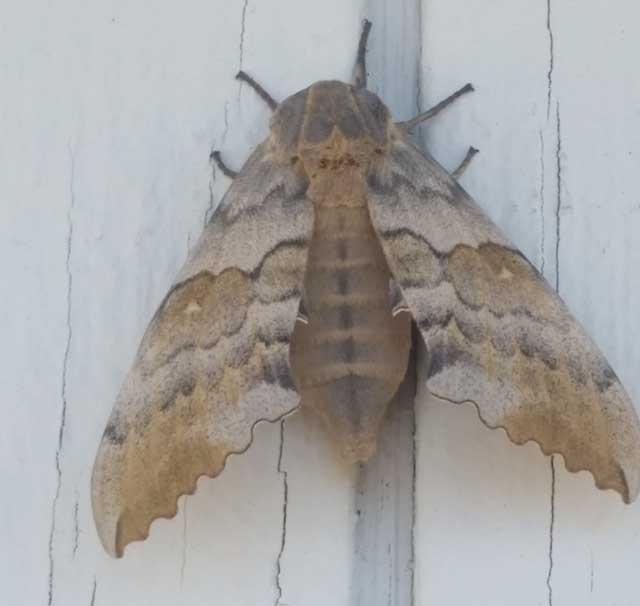
Pachysphinx occidentalis female, Phelan, San Bernardino County, California,
April 5, 2015, courtesy of Jennifer Rosta.
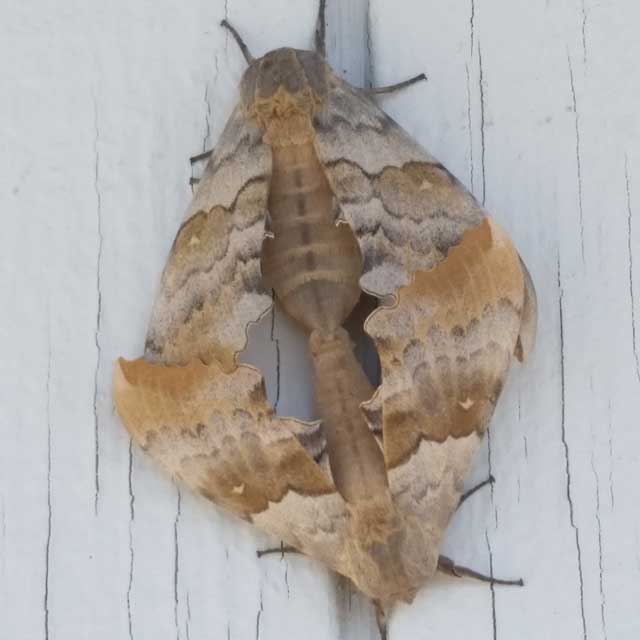
Pachysphinx occidentalis in copula, Phelan, San Bernardino County, California,
April 6, 2015, courtesy of Jennifer Rosta.
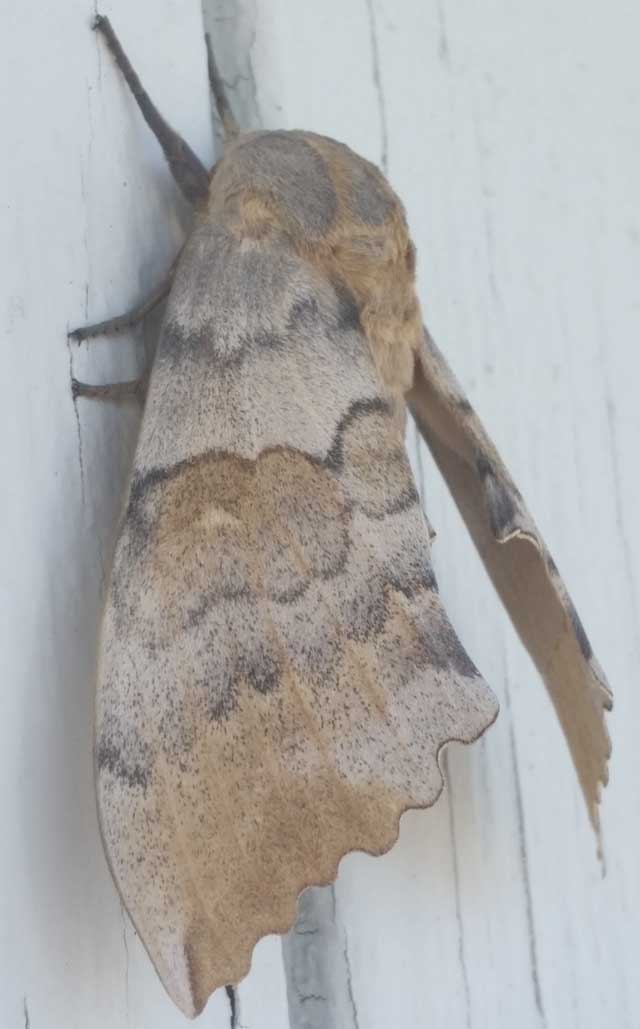
Pachysphinx occidentalis post copula, Phelan, San Bernardino County, California,
April 7, 2015, courtesy of Jennifer Rosta.
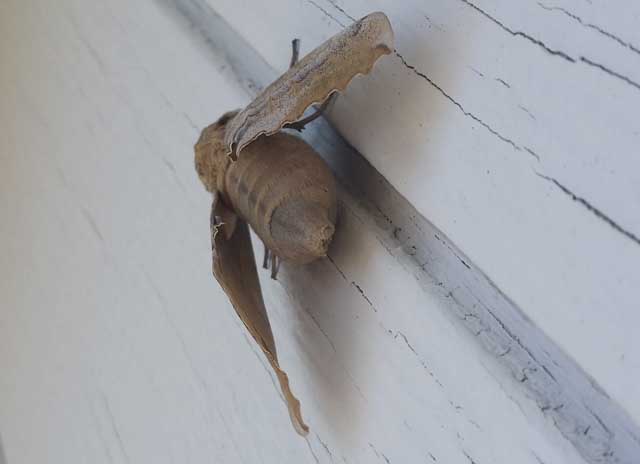
Pachysphinx occidentalis swollen abdomen, Phelan, San Bernardino County, California,
April 7, 2015, courtesy of Jennifer Rosta.
EGGS, LARVAE, PUPAE:Pachysphinx
occidentalis eggs are quite large and a translucent pale green, more towards pale yellow.
Larvae feed on cottonwood and poplar (Populus) and willow
(Salix). Pachysphinx occidentalis male, courtesy of
Martin Jagelka
I have not reared P. occidentalis, but I have reared a very close relative, P. modesta, many times on Prince Edward Island. I suspect the life histories are probably very
similar. Here are notes for modesta: Eggs are fertilized as they are deposited while they are being coated with a mix of female glue and stored male sperm during
egg laying. At room temperature, the eggs incubate for about ten days, more quickly if it is warmer. Larvae feed for four to five weeks, attaining lengths of approximately 3.5 inches/9.2cm
before descending the host plant to excavate subterranean chambers in soft earth.
Here in Canada and in the northern United States, P. modesta seem to have a single brood each year. I am not sure, but it appears from sighting data that
P. occidentalis, at least those from the southwestern US, appear to have at least two broods each year. Adults of this species do not feed, but
rely on fats stored from caterpillar days to sustain an adult lifespan of probably only 6-10 days,
just long enough for mating and egg laying.
|
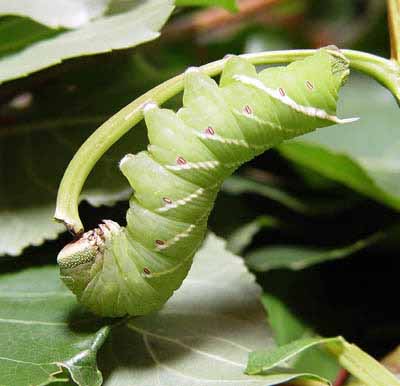 |
Return to U. S. A. Table
Return to Main Sphingidae Index
Return to Smerinthini Tribe
Enjoy some of nature's wonderments, giant silk moth cocoons.
These cocoons are for sale winter and fall. Beautiful Saturniidae moths will emerge the following spring and summer.
Read Actias luna rearing article.
Additional online help available.
Eggs of many North American species are offered during the spring and summer. Occasionally
summer Actias luna and summer Antheraea polyphemus cocoons are available. Shipping to US destinations is done
from within the US.
Use your browser "Back" button to return to the previous page.
This page is brought to you by
Bill Oehlke and the
WLSS. Pages are on space rented from Bizland. If you would like
to become a "Patron of the Sphingidae Site", contact Bill.
Please send sightings/images to Bill. I will do my best to respond to
requests for identification help.
 | 
Show appreciation for this site by clicking on flashing butterfly to the left.
The link will take you to a page with links to many insect sites. |












